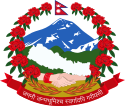Federal Parliament of Nepal
This article has multiple issues. Please help improve it or discuss these issues on the talk page. (Learn how and when to remove these template messages)
|
Federal Parliament of Nepal संघीय संसद, नेपाल | |
|---|---|
 | |
| Type | |
| Type | |
| Houses | National Assembly, House of Representatives |
| History | |
| Founded | 5 March 2018 |
| Preceded by | Legislature Parliament of Nepal |
| Leadership | |
Chairman of the National Assembly | Ganesh Prasad Timilsina, NCP since 15 March, 2018 |
Deputy Chairman of the National Assembly | Sashikala Dahal, NCP since 19 March, 2018 |
Speaker of the House of Representatives | |
Deputy Speaker of the House of Representatives | Shiva Maya Tumbahamphe, NCP since 16 March, 2018 |
Leader of the House of Representatives | |
| Structure | |
| Seats | 334 59 assemblymen 275 representatives |
 | |
House of Representatives political groups | Government (174)
Opposition (63)
Other opposition (33) Others (5)
|
 | |
National Assembly political groups | Government (39)
Opposition (13)
Other opposition (4) Others (3)
|
| Elections | |
| Parallel voting | |
| Single transferable vote & First-past-the-post | |
Last House of Representatives election | 26 November and 07 December 2017 |
Last National Assembly election | 06 February 2018 |
| Meeting place | |
 | |
| International Convention Centre, New Baneshwor, Kathmandu, Nepal | |
| Website | |
| www | |
| Constitution | |
| Constitution of Nepal | |
 |
|---|
|
|
The Federal Parliament of Nepal (Nepali: संघीय संसद नेपाल, saṅghīya sansada Nēpāl) is the federal and supreme legislative body of Nepal. It is a bicameral federal legislature that consists of the National Assembly as upper house and the House of Representatives, as lower house.
History
Legislatures of Kingdom of Nepal
The former Parliament of Nepal was dissolved by King Gyanendra in 2002, on the grounds that it was incapable of handling the Maoist rebels. The country's five main political parties have staged protests against the king, arguing that he must either call fresh elections or reinstate the elected legislature. In 2004, the king announced that parliamentary elections would be held within twelve months; in April 2006, in response to major pro-democratic protests, it was announced that Parliament would be reestablished.[2]The current prime minister of Nepal is Khadga Prasad Oli.
Interim Legislature of Nepal
After the success of the April 2006 people's movement, on January 15, 2007, the old parliament was dissolved and replaced by the 330-member interim legislature of Nepal.[citation needed] By the legislature an Interim Constitution was promulgated and a constituent assembly election was held in April 2008. The 601-member assembly on 28 May 2008 abolished the 238-year-old monarchy and declared the country a republic. The parliament constituent assembly, which was initially given two years to draft a new constitution, was dissolved on 27 May 2012 after its failure to draft a new constitution due to differences over restructuring the state.
Legislature Parliament of Nepal
The Legislature Parliament of Nepal was expired by 21 January 2018 (7 Magh, 2074 BS).[3]
The second Nepalese Constituent Assembly was converted into legislative parliament of Nepal after the promulgation of the constitution on September 20, 2015.[4] The second Nepalese Constituent Assembly was formed after failure of first Constituent Assembly to draft a new constitution. The second Nepalese Constituent Assembly has completed its task by successfully promulgating the constitution on September 20, 2015.
Composition
According to the Constitution of Nepal 2015 Nepal has a two chamber Parliament (संसद)[5]. The House of Representatives (प्रतिनिधि सभा) has 275 members elected for a five year term, 165 from single-seat constituencies and 110 from a proportional party list. The National Assembly (राष्ट्रिय सभा) has 59 members elected for six years term. Among the 59 members three members are nominated by the President. The remaining 56 are elected from 7 provinces equally (Eight each) including 3 female 1 Dalits and 1 from differently abled groups.
President of Nepal
House of Representatives
National Assembly
Powers and rights
Parliamentary committees
Women's Representation
Nepal currently has a woman as speaker of the Parliament. On Oct 16, 2015 Parliament unanimously elected UCPN-Maoist lawmaker Onsari Gharti Magar, as the speaker of the house.[6] Women’s representation in the Parliament of Nepal has increased in the Constituent Assembly, which will have immense role to draft the future constitution of Nepal.[2]
Parliament House
See also
References
- ^ "Krishna Bahadur Mahara Elected Speaker". Nepal Republic Media. Kathmandu, Nepal. 10 March 2018. Archived from the original on 15 March 2018.
{{cite news}}: Unknown parameter|deadurl=ignored (|url-status=suggested) (help) - ^ a b "Nepal's Political Development: Nepal Constituent Assembly Portal". Nepalcaportal.org. Retrieved 2010-04-10.
- ^ "संविधानसभा प्रथम". parliament.gov.np. Retrieved 13 December 2017.
- ^ http://timesofindia.indiatimes.com/world/south-asia/Nepal-elects-first-woman-speaker-of-parliament/articleshow/49420818.cms
- ^ http://constitution.org.np/userfiles/constitution%20of%20nepal%202072-en.pdf
- ^ http://timesofindia.indiatimes.com/world/south-asia/Nepal-elects-first-woman-speaker-of-parliament/articleshow/49420818.cms
